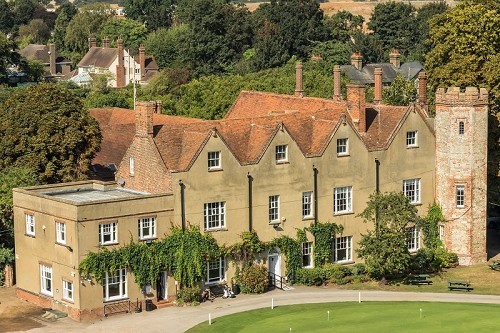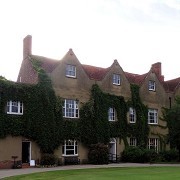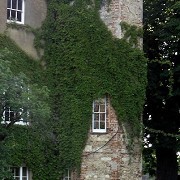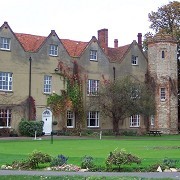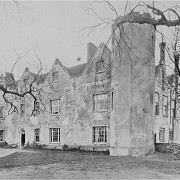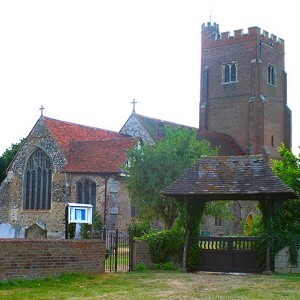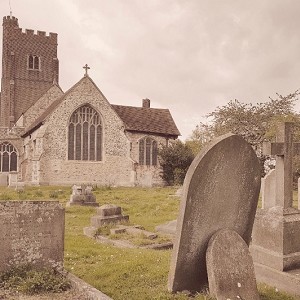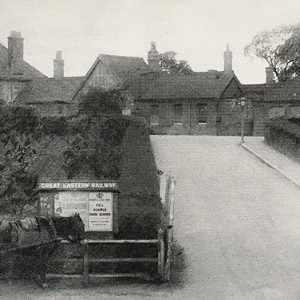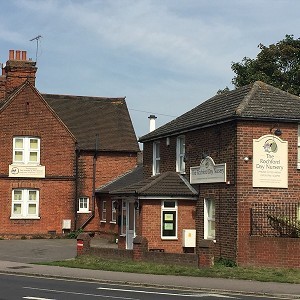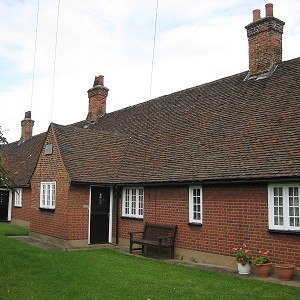About Rochford Hall (HT)
Press this YouTube link or read below.
With thanks to Dr. Michael Clark for allowing us to use extracts from his book ‘Rochford Hall’.
Rochford was a major administrative centre for the area of Rochford Hundred, so it is natural that the original Rochford manor house (or hall) and subsequent Rochford Hall were built here, near the centre of the Hundred. The hall has been owned by many nobles through the centuries.
Rochford is first recorded in the Domesday Book of 1086, when it was a Manor held by Swein (or Sweyne) of Essex, the largest landowner in the area who had inherited 55 Manor Estates from his father, Robert FitzWimarc, a favourite French noble of William the Conqueror. The manor house that existed in Domesday times was probably on the site of Rochford Hall and the adjacent parish church. This was a prime location, close to the extensive woodland and surrounded by good farming land. It was also close to the River Roach but far enough away from the unpleasant marshy area that surrounded the river’s tributaries, which even as late as the 18th century were described as having been “from want of drainage...formerly subject to malaria, mildew, and stinking fogs, the inhabitants suffering much from ague”.
Many of the subsequent Lords of the Manor were closely linked with kings and queens of England and held high positions in the country’s administration. There is so much history connected to this site and the buildings that we can only give a flavour of it here.
The Manor was later held by the de Rochford family and it was Sir Guy de Rochford who, in 1247, obtained permission from Henry III to hold a market and fair. Instead of establishing this close to his manor house, it was set up about half a mile to the east, close to the lowest bridgehead on the Roach estuary. The town then grew around this market, so it sounds like Guy knew his onions and arranged things nicely so that his tenants were a good distance from his more luxurious abode!
In 1340, Edward III granted the Manor of Rochford to William de Bohun, Earl of Northampton. In 1381, the arranged marriage took place at Rochford Hall of Mary de Bohun, aged 11, and Henry Bolingbroke, aged 14. It was some years before they lived together but they then had six children before Mary died unexpectedly in 1394. Henry became King Henry IV in 1399. So, although Mary never became Queen, her son became King Henry V, the hero of Agincourt. Unfortunately, nothing survives today of the extensive building works carried out at the hall in the 1430’s by the de Bohuns, as the old stone manor house was replaced by the grander project that would eventually become a magnificent Tudor mansion, with turrets, gables and twisted brick chimneys.
James Boteler (or Butler, which is probably derived from the Boteler’s hereditary title of ‘Butler of Ireland’ given by Henry II in around 1170) was the 5th Earl of Ormond. He inherited Rochford Hall from his ‘de Bohun’ grandmother around 1450 and later added Viceroy of Ireland and Earl of Wiltshire to his titles. He supported Henry VI and the Lancastrian faction during the ‘Wars of the Roses’ and became Earl of Wiltshire. He fought in a number of battles but was executed following the Yorkist victory at Towton in 1461. As a result, his family lost possession of Rochford Hall when the Manor was given to the Duchess of Exeter, the Woodvilles, and then to the Greys.
In 1485, Henry VII became the first Tudor king and Rochford Hall was returned to James Boteler’s brother, Thomas, 7th Earl of Ormond. The Ormond coat of arms appears on the fine brick tower of the church, which presumably they paid for and built, as well as adding to the Hall. When Thomas Boteler died in 1515, his 72 Manor Estates were divided equally between his two daughters, Anne and Margaret, with Rochford being inherited by Margaret. Margaret had married Sir William Boleyn, who died in 1505, so in 1515 it was their son Thomas Boleyn who obtained possession of Rochford Hall and the manor estate.
The Boleyns had a number of manor houses, so it probably wasn’t at Rochford that Anne was born. Thomas Boleyn and his wife Elizabeth (née Howard, the daughter of the Duke of Norfolk) had three children (Mary, Anne and George) who were probably born at Blickling in Norfolk.
Henry VIII initially had eyes only for Mary, “The Other Boleyn Girl”, who became his mistress, but later it was Anne who became Henry VIII’s second wife and the mother of the future Elizabeth I. Anne and her brother George were both beheaded in 1536. Anne Boleyn is the most famous person associated with the Hall, although it is unclear how much, if any, time she spent there. Anne’s sister Mary, with her second husband Sir William Stafford, lived at the Hall for some time and Mary died there in 1543. The location of her grave is unknown.
Sir Henry Carey, Lord Hunsdon, Mary’s son by her first marriage, sold the Manor with other property to Lord Rich in 1550 for £2,000. The lands acquired by Rich included 2000 acres of arable, 500 acres of meadow, 3000 acres of pasture, 1000 acres of wood, and 2000 acres of furze and heath. Lord Rich remodelled the manor house as a vast Tudor mansion, a small part of which survives today.
Lord Rich appears to have been quite a schemer, a political animal and master of court intrigue, able to switch allegiance at the drop of a hat and to survive, and indeed prosper, throughout the reigns of Henry VIII up to Elizabeth I. In serving Henry VIII, he was Speaker of the House of Commons, was involved in the dissolution of the monasteries and in the interrogations that led to the ending of some of the King’s marriages. Edward VI made him Lord Chancellor of England. Under the devout Catholic Mary I, as a member of the Queen’s Council and with a keen sense for survival, he actively supported her statutes against heresy and 52 Essex Protestants were burnt at the stake during Mary’s reign. However, there is no evidence that he was involved with the martyrdom in Rochford of John Simson. When Anne Boleyn’s daughter Elizabeth came to the throne, he managed to stay in favour, was made elder statesman in Parliament and was charged with preserving religious stability in Essex!
In addition to Rochford Hall, Lord Rich owned Southchurch Hall, Sutton Hall, Hawkwell Hall, Milton Hall, Prittlewell Priory, Hadleigh Castle and numerous other properties in the area. He died at Rochford Hall in 1567 and a grand procession conveyed his body to Felsted for internment in the parish church. In his will, Rich left instructions for 6 Almshouses to be built for the poor of Rochford, but there were problems with the will and the Almshouses in West Street were not built until about 50 years after his death.
There are many more tales surrounding Rochford Hall. In the late 1500’s, it was the scene for dissenters from the Established Church, supporting the Congregationalists and later services held in the Hall’s chapel were said to have fuelled the emergence of Essex Puritanism, which was subsequently taken to America by the Pilgrim Fathers. Oliver Cromwell’s daughter Frances married into the Rich family and possibly lived at Rochford Hall. Then much more recently, during World War II, airmen were housed at the Hall and the Hall also suffered some bomb damage.
The Hall was subsequently owned by various prestigious families, including Earl Tylney, the Wellesleys and the Tabors. In 1896 the east wing and some of the parkland were let to Rochford Golf Club and in 1980 the club purchased the hall, and the derelict barns were made into luxury houses, built in keeping with the Hall architecture.
There has been a lot of confusion about the dating of Rochford Hall. This Grade I listed building is constructed from at least three different types of stone, as well as brick and timber. However, the existing building is mostly of one date, being constructed in whatever materials were available, and then plastered over so that at a distance it looked as if it was built of stone. The top or attic storey is timber-framed and clad in brick. During the reconstruction of the barns, large quantities of carved stonework were found which could only have come from a church or monastic building. This suggests that the present Hall dates from after the dissolution of the monasteries in 1539 when these buildings were pulled down and their materials sold for re-use.
The Hall in Lord Rich’s time was huge, one of the largest in the country, but a fire in 1760 destroyed much of the building and only around a third of it remains today. An octagonal tower which has been found by excavation to the south of the existing building shows that it was about 200 feet square with possibly four internal courtyards. Excavation has also revealed that it was surrounded by a wide moat.
| Address: | Hall Road |
| Town: | Rochford |
| Postcode: | SS4 1NW |
| Categories: | Historical, Point of Interest, Rochford |
Rochford Hall (HT) is included in the following trails:
Main Heritage TrailOuter Heritage Trail7 Centuries of ArchitectureChurches, Faith & Peculiar PeopleMurder, Mystery & Mischief!
